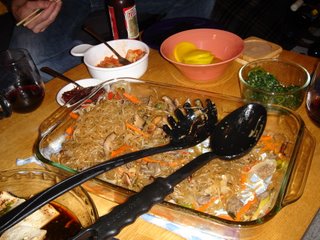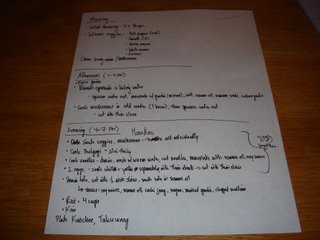Last Sunday Night Dinner: Jonathan's Guest Post

Although I've been in the Sunday dinner rotation for awhile, I've only hosted dinner several times. The past two times I hosted I tried to do a typical Korean meal, which in the end turned out to be only semi-Korean. This is partly because I don't know where the Korean grocery stores are in the Boston area other than Super 88, which is more a pan-Asian grocery store (double shame on me). So when Lissa offered to drive me out to Framingham where she said there was an authentic Korean grocery store i.e. one where the proprietors speak Korean and only a few words of English, I figured this would be a good chance to cook some more authentic Korean food..
The main dish I was planning to cook is called japchae. Essentially it is a noodle dish with beef (bulgogi) and an assortment of vegetables. The noodles are clear and made from potatoes. Most japchae dishes include colorful vegetables like carrots, onions, green onions, bell peppers, mushrooms, spinach, etc. along with the beef. As it turns out, the Korean grocery store, Asinayo, had everything I needed. Although I understand Korean, I can only speak a few words (I was born in America), but when I told the clerk I was making japchae, she pretty much did the shopping for me. I got the necessary ingredients as well as a few extra items that would work as side dishes. One could say I was quite content when I left the store...there's nothing like shopping at truly authentic establishments.
Before I go any further, I want to say a few words about my experiences with Korean food. I grew up eating mainly Korean food all the time, compliments of my mother. Even at Thanksgiving dinner, next to the turkey, stuffing, and mashed potatoes, there would be a bowl of steamed rice and some kimchee, almost to remind us that we were still Korean (I was blasting Public Enemy at the time). For me, Korean food is what you would call comfort food, and so I tend not to cook Korean food that often because I know I'll be eating a lot of it when I visit my parents. To be honest, I also know no matter how hard I try to cook Korean food, it will never be as good as mom's, but for the sake of the Sunday night dinner and Grey's Anatomy, I was damn sure gonna try.
After getting back from the Korean grocery store, I made a brief prep list and schedule for the next day. The last time I hosted, I grossly miscalculated how much time I would need, so I wanted to make sure I got a head start. Below is a picture of my schedule for Sunday, which I more or less followed. Anal retentive? Perhaps, but if I am to have a cooking disaster, I would rather it not be in front of people. I started in the morning making a salad dressing and chopping vegetables for the japchae dish. The salad dressing is a recipe I got from my mother (big surprise), and it is by far the best homemade salad dressing recipe I've ever had. I don't know if it has a name, but for now I'll just call it:
"Mom's Damn Good Asian Salad Dressing"
1 teaspoon salt
1/2 teaspoon coarse ground black pepper
2 tablespoon sugar
3 tablespoon vinegar
1 teaspoon soy sauce
1 teaspoon sesame oil
1/4 cup vegetable oil
Whisk together all ingredients or add to a bottle and shake. Topping off the salad with sesame seeds and/or cochoo gado (crushed red pepper) is also a nice touch too.
For the japchae dish, there was a lot of vegetables that needed chopping, and since I don't have a mandoline, there was knife work to be done. Also, the dried mushrooms that I bought (shitake) needed to soak in cold water for an hour, and I had to blanch the spinach in boiling water. I chopped my way through red and yellow peppers, green onions, a white onion, a zucchini, and some carrots (you basically need to julienne the veggies). After the mushrooms were done soaking, I squeezed the excess water from them, and I did the same with the spinach after boiling it for 3-4 minutes. It is amazing how much spinach shrinks after blanching, and I realized that there was nowhere near enough spinach to use in the japchae dish. This was not a complete disaster though because I did have other green vegetables in the mix, and also because marinated spinach is a common side dish, as Lisa and Anna can attest to after our Korean feast at Wuchon House in Union Square. The marinade for the spinach is rather simple: minced garlic, sesame oil, sea salt, sesame seeds, and cochoo gadoo (crushed red pepper). I let that sit at room temperature in a covered bowl.
With the vegetables prepped for the japchae, I turned my attention to the meat. I took the easy way out on this one. The main meat dish in Korean cuisine is called bulgogi - thinly sliced ribeye beef that's marinated in sesame oil, soy sauce, sugar, garlic, green onions, and if you want, rice wine vinegar. Whenever I visit my parents, my mom marinates a whole bunch of bulgogi, then freezes them down in Ziploc bags, in 1/2 pound aliquots (yes, I work in a lab too), and I get to take this back up with me to Boston. For the japchae, I pulled out roughly 1 1/2 pounds of bulgogi to thaw in the refrigerator the day before. All I had to do now was cut the bulgogi into smaller strips and cook it with the rest of the vegetables. Pre-marinated bulgogi is a beautiful thing, I must say. On that note, pre-marinated anything is a beautiful thing.
The next step is to sauté the vegetables and the bulgogi. For the vegetables, I sautéed them separately in vegetable oil and salt. Normally I would use sesame oil, but since I was seasoning the noodles with sesame oil, I didn't want to go overboard. I don't know about Chinese and Japanese cuisine, but when preparing Korean food, sesame oil is analogous to olive oil for Italian cuisine. I think it has a much stronger flavor than olive oil, so you have to use it in moderation. After I finished sautéing the vegetables and mushrooms, I cooked the bulgogi in a skillet and then set everything aside while I cooked the noodles. Because the noodles are so thin, they cook in about 5-6 minutes; it is important to rinse the noodles afterwards though because the noodles release a lot of starches and other preservatives that are common among dried noodles. Once the noodles are rinsed, I spent a fair amount of time with kitchen scissors chopping up the noodles because they are quite long. The noodle marinade consists of soy sauce, sesame oil, and sugar, which I whisk together in a separate bowl then pour over the noodles. The noodles soak up the marinade very fast, but you have to toss the noodles to ensure the marinade distributes evenly.
With the noodles marinated, I was ready to add in the vegetables and the bulgogi. I tossed the vegetables with the noodles first and then separated a portion of that out for a vegetarian option, and then mixed the bulgogi with the other batch. Unfortunately I didn't think to take pictures at this time, which is why the pictures show the japchae half eaten. I covered the japchae with aluminum foil and placed it in the oven, which I kept at the "warm" setting while I moved onto the other dishes. Next up was a marinated tofu dish my mother made. I never really liked tofu until I had this dish, and I had made it the last Sunday dinner I hosted and people seemed to like it. One of the purchases I made at Asinayo was organic firm tofu which came as a block. You can buy soft tofu, but those tend to fall apart more easily when you sauté them and more useful in soups or stews. I chopped the firm tofu (dubu) into 1-inch squares, about a 1/2-inch thick. I fried them lightly on both sides in sesame oil, about 3-4 minutes a side over low-medium heat. The sauce for the tofu is pretty much the same as the other marinade:
1/2 cup sesame oil
1/2 cup soy sauce
1/4 cup sugar (or to taste)
2 cloves minced garlic
1-2 tablespoons toasted sesame seeds
Crushed red pepper to taste
Finely chopped scallions or chives
Pour the marinade over the lightly sautéed tofu, and that's that. Those were the two main dishes for the dinner, with the japchae being the main course.
For side dishes, I served steamed rice, the marinated spinach, kimchee (pickled spicy cabbage), takuwon (pickled radish), kimchee mandoo (dumplings filled with kimchee), kim (dried seaweed seasoned with sesame oil and salt), and for people who wanted their food spicier, cochi jang (hot and spicy pepper paste). With the exception of the rice, I bought all these items at Asinayo. My mom does all her own pickling, so she has these huge pickling jars filled with kimchee and takuwon. In my case, the kimchee, takuwon, and cochi jang came straight out of the containers, while the kimchee mandoo were frozen and merely had to be pan-fried in some water for a couple minutes.
I was surprised to find the kim already seasoned in the package, which saved me some time. At the last dinner I cooked, the kim I bought was not seasoned, so I had to do it myself, with some help from Lisa. The seasoning consists of brushing both sides of the seaweed square with sesame oil, placing it on a sauté pan over low-medium heat and cooking it over about a minute or two per side. Afterwards, sprinkle both sides with salt, divide the square into fourths, and you're ready to eat. Although kim tastes good on its own, I also like to make a kind of seaweed wrap with them, where I'll take a square, place some rice in it, some kimchee, and some bulgogi, top it off with some cochi jang, wrap it up, and it's ready to go.
So that was the whole meal, start to finish. This was probably the most authentic Korean dinner I've ever made, although all the sides were store-bought and ready to eat. What this really means is that as long as you know where there's a Korean grocery store, then you can easily prepare a Korean dinner.
Japchae (Mom's version)
(This is a "loose" recipe in that you can use whatever vegetables you like in whatever amount you like. The version here doesn't include the spinach since that didn't make it into the dish)
1 1/2-pound package of potato noodles
A good sized handful of dried shitake mushrooms (pre-sliced if possible)
1-2 pounds bulgogi beef (sliced ribeye marinated in equal parts soy sauce, sesame oil, sugar, with sliced garlic and scallions)
1 red bell pepper (thinly sliced)
1 white onion (thinly sliced)
1 bundle of green onions (cut into 1-inch pieces)
2 carrots (cut into thin strips)
1 zucchini (cut into thin strips)
Soy sauce
Sesame Oil
Sugar
Salt
1.) Slice vegetables into very thin strips or as directed above. Set aside
2.) Soak the mushrooms in cold water for an hour. Squeeze excess liquid from the mushrooms. Sauté mushrooms in sesame oil with salt and pepper over moderate heat, then set aside.
3.) Sauté vegetables in vegetable oil and salt over moderate heat (4-5 minutes). (Although I sautéed the vegetables separately, you can sauté them together to save time.) Set aside.
4.) Sauté bulgogi until beef is cooked all the way through (5-6 minutes). Set aside.
5.) Cook potato noodles in boiling water (6-7 minutes). Thoroughly drain and rinse noodles with water. With kitchen scissors, chop noodles up into smaller sizes (5-6 inches). Mix 1/2 cup soy sauce with 1/4 cup sesame oil and sugar to taste. You can adjust the amounts to your liking. Just make sure the noodles are evenly marinated with sauce.
6.) Mix vegetables, noodles, and bulgogi in a large bowl and serve.






2 comments:
Hehe, well, let's just say I can follow a protocol, and we'll leave it at that.
I don't really know how I came across this very old post when looking for a few mandoo recipes, but did you know that there's a large Korean/Japanese grocery store in Union Square in Somerville? If not, then you should check it out as it's much closer than Framingham! It's called Reliable Market and it's been around for close to 25 years so hopefully you can find all you need to there. :)
Post a Comment